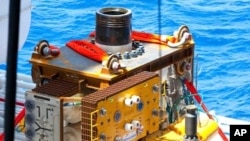BP officials said Monday that they are close to installing a new cap on its leaking oil well in the Gulf of Mexico that has befouled beaches in four U.S. states and spread plumes of crude oil over a large are of the water. BP says full containment of the leak could come within days.
In a telephone briefing with reporters, BP's Chief Operating Officer Doug Suttles said a new, tighter-fitting cap has been lowered over the leaking well and will be attached by engineers operating underwater robots. But, he said, the success of the 68,000 kilogram cap will not be known until integrity tests are completed to ensure that it is capturing all of the gushing oil.
"The concern with the integrity test is actually below the sea bed and it is just verifying that there is not a problem with the casing, at some point, which could allow the flow to escape outside of the casing," said Doug Suttles.
Suttles added that the tests will determine whether there is strong pressure in the cap, which would mean that the flow of oil is contained. If there is low pressure, he said, that could indicate a leak somewhere else that is diverting oil from the main well head. He said the tests should take 48 hours to complete.
If all goes as planned, surface ships above the blown-out well will capture the oil as it flows up a pipe from the cap containing the leak. Among the vessels on hand is the Helix Producer, which can capture 3.8 million liters of oil a day.
But Doug Suttles says that a successful capping of the well would not be the end of the operation and that efforts to drill two relief wells will continue.
"Ultimately, to make sure this well can never flow to surface again and therefore the risk is removed, we actually need to kill it down at the reservoir and cement it up so that it can never flow again to the surface," he said. "So we still have to complete the relief well activity."
Suttles says that drilling on one of the relief wells might reach the target point of intersection with the main well within a few days. He said the relief wells could be finished and the leaking well sealed by the end of this month, although the official time frame for completion is mid-August.
Also on Monday, a presidential commission to investigate the accident and recommend policies to prevent future underwater oil well disasters began a two-day hearing in New Orleans. The purpose of the session is to learn more about the effect the spill has had on people in the Gulf region, especially those whose livelihoods have been disrupted by the shutdown of the fishing and shrimp industries, and oil industry laborers who are out of work because of a moratorium on deepwater drilling projects in the Gulf of Mexico.
The moratorium was struck down by a federal court amid complaints from Gulf coast governors and energy industry officials that it was too broad and that it would put tens of thousands of people in the region out of work.
The Obama administration issued a new moratorium on Monday. Unlike the earlier one, it is not based on water depth, but on technologies employed in the drilling process. The new moratorium runs through November 30. It is intended to suspend possibly risky operations and to ensure that drillers are prepared to handle spills.
BP Making Progress with New Cap over Leaking Gulf Well
- By Greg Flakus









